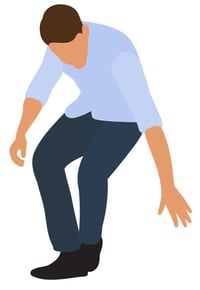
By
Rob Boyle
October 10, 2024
Updated
October 10, 2024

How can I prevent an injury from falling?
Each year there are many serious and sometimes fatal incidents in the industry, and numerous workers are injured.
Proper housekeeping in work and walking areas can contribute to safety and the prevention of falls.
Naturally, the goal is not to fall. However, the possibility of a fall still exists. In the event that you are unable to avoid a fall, it's important to be aware of how to properly fall in order to avoid a serious injury.
What should I do if I can't avoid falling?

- Tuck your chin in, turn your head, and throw an arm up. It is better to land on your arm than on your head.
- While falling, twist or roll your body to the side. It is better to land on your buttocks and side than on your back.
- Keep your wrists, elbows and knees bent. Do not try to break the fall with your hands or elbows. When falling, the objective is to have as many square inches of your body contact the surface as possible, thus, spreading out the impact of the fall.
What are the proper ways to fall?
What to do if you are falling forward
- Hit the ground with the entire palm and forearm - This reduces the likelihood of a wrist fracture
- Turn your head to the side - This reduces risk of hitting your nose or mouth on the ground
- Try to land on your palms and forearms in a push-up position without letting the rest of your body touch the ground
- Breathe out
- Avoid locking your joints
What to do if you fall to the side
- Hit the ground with the entire palm and forearm on the side you fall on - If the left side, use the left arm, etc.
- Grab your hip with opposite arm- If falling to the left, use right arm to grab the hip
- Tuck your chin to your chest to avoid your head hitting the ground
- Squat
- Try to roll to your back
- Avoid landing directly on your hip
What to do if you fall backwards:
- Bend at knees and squat
- Tuck chin to avoid hitting head
- Hit the ground with forearms first
- Round your back
How can I prevent myself from falling off a ladder?
Ladders are common tools that many people assume they know how to climb safely when, in fact, they may not. Safe and efficient use of ladders is not complex or difficult, but it does require that the user practices proper ladder safety habits.
Most of the basic safety rules that apply to the safe use of a ladder includes:
- Wear clean, slip-resistant shoes.
- Avoid using ladders with loose or missing parts or that might sway or lean to the side.
- Check the Duty Rating of a ladder. It should be greater than the total weight of the climber, tools, supplies, and other objects placed upon the ladder.
- Use the proper size. The length of the ladder must be sufficient so that the climber does not have to stand on the top rung or step.
- Check the ground. When the ladder is set up for use, it must be placed on a firm ground without any type of slippery condition present at either the base or top support points.
Do not share a ladder. Only one person should be permitted on the latter at a time, unless the ladder is specifically designed for more than one climber (such as a Trestle ladder).
What causes ladder falls?
Factors contributing to falls from ladders include the angle and positioning of the ladder during use. When setting up your ladder, keep the following in mind:
- Non-self-supporting ladders which must lean against a wall or other support should be positioned at such an angle that the horizontal distance from the top support to the foot of the ladder is about one-fourth the working length of the ladder.
- When using wooden ladders, the angle should equal about one-eighth the working length. This minimises the strain of the load on ladder joints that may not be as strong as on commercially manufactured ladders.
Everyone should be cautious when climbing ladders. The safety of the load, angle, and rungs of the ladder is crucial.
